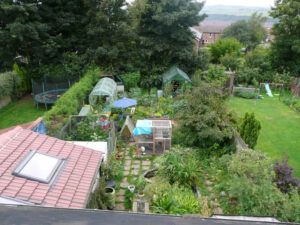As more and more people realize the benefits of sustainable living, permaculture gardening will only grow in popularity. For those who are just learning about this style of gardening, they may have questions. All you need is a backyard or an area where you can garden, such as a courtyard or even a balcony. Let’s take an in-depth look at how you can get started. Permaculture, which is short for “Permanent Agriculture” is a system of agricultural and design principles centered around simulating or directly utilizing the patterns and features observed in natural ecosystems. Permaculture is now a growing global movement that has changed many people’s lives on a fundamental level.
Check out our other post on the 12 Principles of Permaculture.
How do I get started?
The beauty of a permaculture garden is that there is no one way to go about establishing yours. A person is free to individualize theirs as much as they like. In order for a garden to qualify as being a part of permaculture, it must utilize certain principles.
The size of the garden will help to determine this, as well as the amount of permaculture principles you will include. Some may choose to incorporate more traditional designs, while others decide to go for a more full blown permaculture look.
What are the principles of permaculture?
Permaculture hinges on a few different points. First of all, soil preservation is key. Protecting the soil by using mulches and keeping it covered at all times is one way to work with nature, instead of against it.
Covering soil allows it to remain safe from rain, which compacts the top soil and washes away valuable nutrients. It also enables the soil to avoid receiving too many direct UV rays, which causes the death of living things such as bacteria, fungus, and other micro fauna. Soil is alive!
A permaculture garden also uses the plant stacking technique, to emulate their growth in nature. The gardener is given a much better usage of space and a more productive growth season by using this method.
It is important to cycle your plants properly, planting new ones as the old ones reach the end of their fruiting. This keeps a garden vibrant and healthy, while avoiding bare patches of soil. If you’re in a warm climate, use perennial plants and save your self the time of restarting each season. Certain perennial veggies can produce nutritious food for years on end.
Permaculture gardeners plant their crops in groups, to better protect them from the elements. Your garden is much more resilient when you do not leave plants out by themselves. I recently did a post on companion planting that can help give you learn which plants benefit each other when planted together.
In addition to plants, various livestock can and should be incorporated into your garden system. They can help by eating garden waste, keeping insect populations at bay, producing nitrogen rick fertilizer and serving as another part of your garden’s food chain.
How do I go about setting up my garden?
Permaculture garden planning can be a large task, which is why experts recommend breaking it down into smaller tasks. Having a design that you know you will stick to is just the beginning. After that, you must determine the scale of the garden, whether it will be large or small. You need to decide what sort of size you can cope with since you don’t want a tonne of overgrown plants and flowers.
 Once these factors have been decided, it’s time to decide what you will plant, where you will plant it and why. Adhering to the correct growing seasons is beneficial to gardeners. It is recommended that beginners start small and give themselves room to expand their permaculture garden as needed.
Once these factors have been decided, it’s time to decide what you will plant, where you will plant it and why. Adhering to the correct growing seasons is beneficial to gardeners. It is recommended that beginners start small and give themselves room to expand their permaculture garden as needed.
By placing all the large elements of your garden first, you can work around them. Trees and larger plants should be planted initially, with smaller plants being placed last. Irrigation installation is made simpler by completing the process before all of your major plants have been planted.
Building a permaculture garden does not happen overnight. It takes time, dedication and the ability to break one large task into several small ones.
The only way to truly learn? By getting out there and doing it!




GIPHY App Key not set. Please check settings